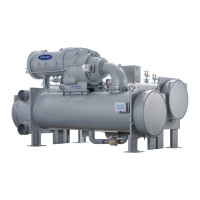
Do you have a question about the Carrier AquaEdge 19XR and is the answer not in the manual?
Lists and explains frequently used abbreviations in the manual.
Provides an overview of chiller components and their identification through figures.
Lists and briefly describes the main components of the chiller system.
Describes the cooler (evaporator) function in the refrigeration cycle.
Explains the condenser's role in heat removal from refrigerant.
Details the function of the motor-compressor in moving refrigerant.
Outlines the functions of the control panel and its interface.
Describes the components within the power panel for 19XR2-E models.
Details the power and control components in the power panel for 19XR6/7 models.
Explains the economizer's function in reducing refrigerant pressure.
Describes the function of starters and VFDs for compressor operation.
Lists features of optional storage vessels used for refrigerant.
Explains the compressor operation and refrigerant flow through the chiller.
Illustrates the refrigeration cycle for single-stage compressors.
Describes how liquid refrigerant cools the motor and oil.
Illustrates the refrigeration cycle for two-stage compressors.
Explains the refrigerant cooling process for unit-mounted VFDs.
Details the oil pump, filter, and cooler system components.
Provides detailed information on the oil flow and lubrication system.
Describes the system for recovering and returning oil to the reservoir.
Discusses requirements for motor starters and VFDs.
Details options for unit-mounted Variable Frequency Drives.
Details the types of unit-mounted starters available.
Explains the function and operation of solid-state starters.
Describes the operation of wye-delta starters for low-voltage motors.
Overview of the microprocessor-based control system and its functions.
Describes the chiller control system's monitoring and regulation capabilities.
Lists and describes the main components of the PIC 6 control system.
Details the sequence for starting, stopping, and recycling the chiller.
Details how to initiate start-up using the HMI interface.
Lists essential job data, equipment, and checks needed before initial start-up.
Instructions to tighten all gasketed joints to ensure a leak-tight chiller.
Outlines the procedure for checking chiller for leaks.
Provides methods for determining and testing for refrigerant leaks.
Provides procedures for performing a leak test on the chiller.
Explains how to perform a standing vacuum test for leak detection.
Recommended procedure if the chiller has been open or contains moisture.
Steps to verify the starter/VFD matches documentation and is correctly installed.
Checks to ensure the starter/VFD installation meets requirements.
Verification steps for mechanical starters.
Guidance on configuring chiller settings via the PIC 6 interface.
Steps to access and set chiller operating parameters.
Instructions for configuring the chiller's time and occupancy schedule.
Confirms configuration values match chiller labels and design data.
Details parameters and procedures for tuning surge prevention.
Instructions for charging refrigerant into the chiller.
Pre-start verification steps before operating the chiller.
Procedure to verify correct motor rotation direction.
Steps to check oil pressure and compressor behavior during shutdown.
Lists operator duties and procedures for starting and stopping the chiller.
Steps to prepare the chiller for extended periods of inactivity.
Procedures for transferring refrigerant using pumpout systems.
Instructions for operating the optional pumpout unit.
Procedures for transferring refrigerant from storage tank to chiller.
Steps to return refrigerant to normal operating conditions after service.
Covers refrigerant properties, adding, adjusting, and leak testing.
Methods and importance of testing for refrigerant leaks.
Tasks to perform weekly for chiller upkeep.
Procedures for checking the oil level and system operation.
Steps for safely changing the oil filter.
Inspection of the refrigerant float system for proper operation.
Guidance for inspecting and maintaining relief valves and associated piping.
Maintenance procedures for compressor bearings and gears.
Steps for inspecting and cleaning cooler and condenser tubes.
Checks for proper installation and condition of starters and VFDs.
Procedure for recalibrating pressure transducers annually.
Overview of the PIC 6 system's troubleshooting features.
How to interpret status and alarm messages on the HMI.
Methods for checking the accuracy of temperature sensors.
Procedures for checking and calibrating pressure transducers.
Adjustments needed for chillers at high altitudes.
Using the quick test feature for diagnostics.
Visual representation of the PIC 6 menu navigation structure.
Wiring details for CCN communication between multiple chillers.
Recommended maintenance schedule based on time intervals.
A checklist for verifying all necessary steps are completed before initial start-up.
Section for recording oil level, pressure drops, and electrical data.
Final checks on controls, safety features, and operating procedures.
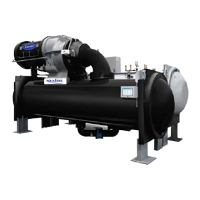
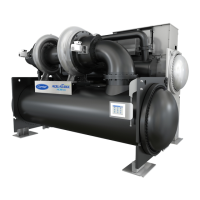
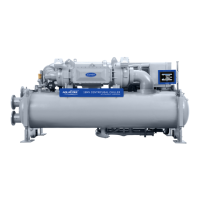
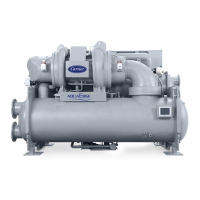
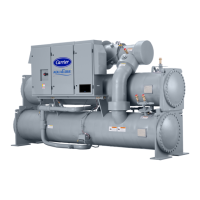
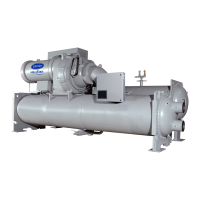
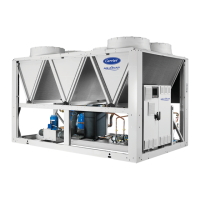
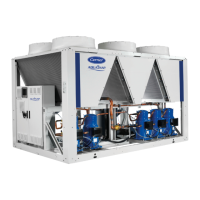




